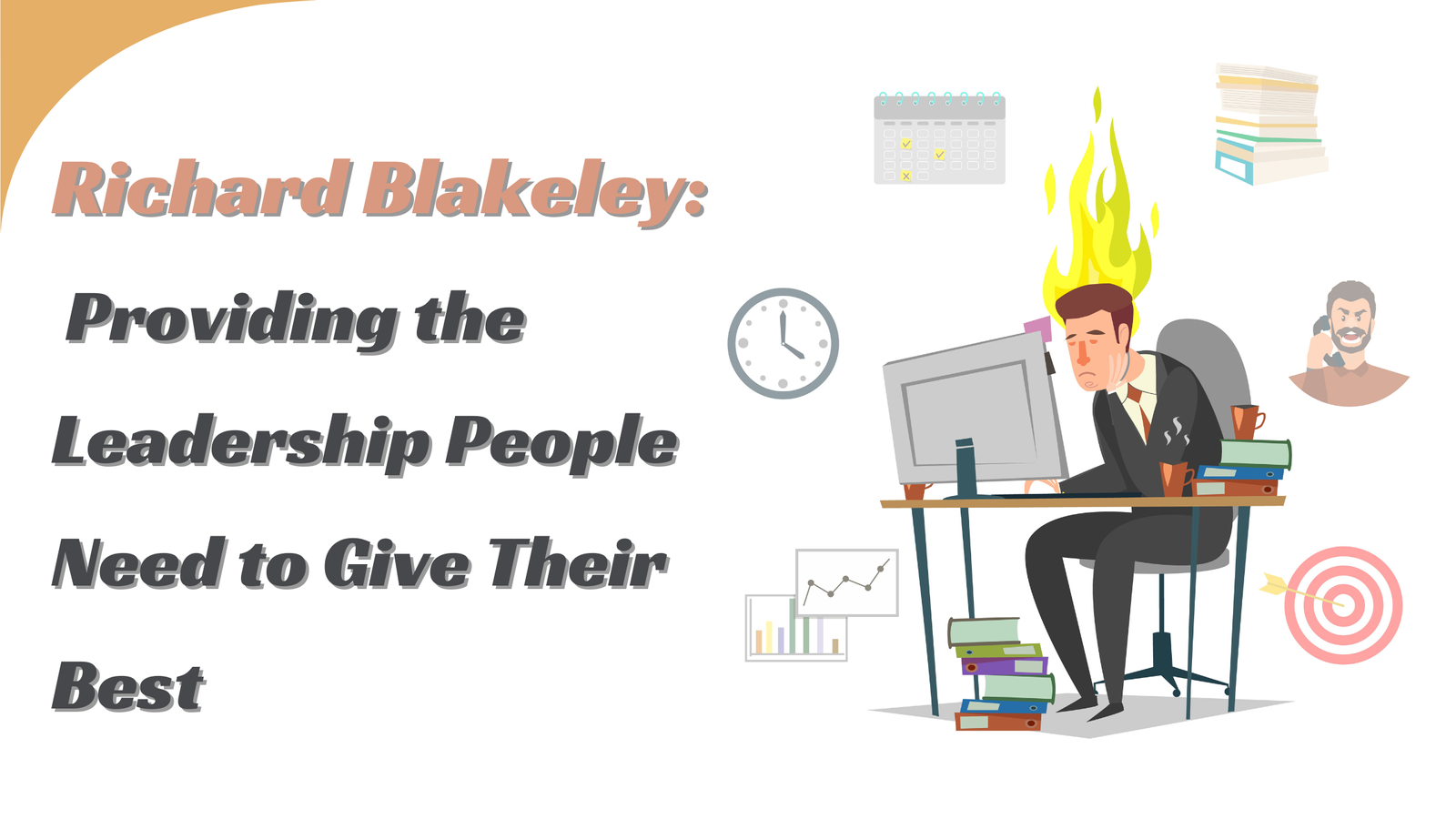Richard Blakeley: Providing the Leadership People Need to Give Their Best (without Getting Burned Out)
- 1 Leadership’s Role in Addressing Employee Burnout
- 1.1 Open Communication
- 1.2 Manage Workloads
- 1.3 Promote Work-Life Balance
- 1.4 Recognition and Appreciation
- 1.5 Professional Development
- 2 Employee Engagement Strategies To Prevent Workplace Burnout
- 2.1 Regular Feedback
- 2.2 Well-Defined Goals
- 2.3 Team Building
- 2.4 Flexible Work Arrangements
- 2.5 Mental Health Support
- 2.6 Recognition Programs
- 3 How to Manage Employee Burnout
- 4 The Impact of Leadership on Preventing Burnout
- 5 The Role of Technology in Managing Burnout
- 6 Conclusion
Burnout has emerged as a critical issue in modern business. As the lines between work and personal life blur, the role of leadership in addressing and preventing employee burnout becomes increasingly significant. Richard Blakeley stands out as a beacon of effective leadership, demonstrating how a thoughtful approach can foster an environment where employees are encouraged to give their best without fearing burning out.
Leadership’s Role in Addressing Employee Burnout

Burnout can cripple an organization’s productivity and morale, but it doesn’t have to. Here are key strategies employed by leaders like Blakeley to create a burnout-resistant workplace:
Open Communication
Creating an atmosphere where employees feel safe to voice their concerns is foundational. It’s about building trust and ensuring employees know their voices are heard and valued. This open dialogue is the first step in identifying and mitigating burnout triggers. When employees feel they can openly discuss their challenges and stressors, it becomes easier to address these issues proactively.
Manage Workloads
Unrealistic work expectations are a common source of burnout. Influential leaders ensure manageable workloads, delegate tasks wisely and provide the necessary resources for employees to succeed. It’s about setting your team up for success, not overload. This involves understanding each team member’s capacity and skills and assigning tasks accordingly, ensuring no one is overwhelmed.
Promote Work-Life Balance
Leaders must lead by example, respecting non-working hours and encouraging staff to disconnect after work. Setting clear boundaries and discouraging constant connectivity can significantly prevent burnout. Encouraging practices such as taking regular breaks, avoiding after-hours emails, and promoting using vacation days can make a substantial difference in maintaining a healthy work-life balance.
Recognition and Appreciation
Acknowledging hard work goes a long way in boosting morale. Appreciation can reinvigorate an employee’s connection to their work and the organization. Regular recognition, whether through formal awards or simple thank-you notes, helps employees feel valued and motivated to continue their efforts.
Professional Development
Investing in employees’ growth shows a commitment to their future in the company. Development opportunities not only prevent burnout but also promote long-term engagement and loyalty. Offering training programs, career advancement opportunities, and personal development resources demonstrates a company’s investment in its employees’ futures.
Employee Engagement Strategies To Prevent Workplace Burnout
Engagement is crucial in combating burnout. Here are strategies leaders can employ:
Regular Feedback
Providing constructive feedback and recognizing contributions helps employees feel valued and connected to their work. Regular check-ins and performance reviews can provide employees with a sense of progress and areas for improvement, fostering a more engaged and motivated workforce.
Well-Defined Goals
Clear objectives give employees a sense of purpose and understanding of how their work contributes to the organization’s success. When employees know what is expected of them and how their efforts align with the company’s goals, they are more likely to stay focused and motivated.
Team Building
A strong sense of community within the team can buffer against burnout. Leaders should encourage activities that strengthen team bonds. Whether through team outings, collaborative projects, or social events, fostering a sense of camaraderie can make work more enjoyable and less stressful.
Flexible Work Arrangements
Flexibility can significantly reduce stress. Offering options like remote work demonstrates a commitment to employees’ well-being. By allowing employees to choose their work environment and schedule, companies can help them balance their personal and professional lives more effectively.
Mental Health Support
Prioritizing mental health through resources like counseling services or stress management workshops can empower employees to manage their well-being effectively. Providing access to mental health resources and promoting a culture that values mental health can reduce stigma and encourage employees to seek help when needed.
Recognition Programs
Implementing systems for peer recognition fosters a positive work culture where efforts are consistently acknowledged. Peer recognition programs encourage employees to appreciate each other’s contributions, creating a more supportive and positive work environment.
How to Manage Employee Burnout

Beyond fostering communication and setting boundaries, there are systemic changes that organizations can adopt to mitigate the risk of burnout further:
Limiting Work Communication
Discouraging work communication tools outside of office hours can help employees fully disconnect and recharge. Establishing clear policies about after-hours communication and setting expectations for response times can help employees feel more in control of their work-life balance.
Encouraging Time Off
Incentivizing vacation time ensures employees take the necessary breaks to prevent burnout. Encouraging employees to use their vacation days and ensuring they take time off regularly can help them return to work refreshed and more productive.
Creating Productive Meeting Guidelines
Streamlining meetings to be as efficient as possible respects employees’ time and reduces unnecessary stress. Establishing clear agendas, limiting meeting times, and only including necessary participants can make meetings more productive and less burdened.
The Impact of Leadership on Preventing Burnout
The leadership shown by individuals like Richard Blakeley illustrates that with the right approach, it’s possible to cultivate a thriving workplace where employees are engaged, productive, and, most importantly, not on the brink of burnout. Leadership isn’t just about guiding the ship; it’s about ensuring every crew member is healthy, happy, and fully equipped for the voyage ahead.
Building a Resilient Organizational Culture
This involves fostering an environment where employees feel supported, valued, and motivated. Leaders can promote a culture of resilience by:
- Encouraging open dialogue and transparency.
- Recognizing and celebrating achievements regularly.
- Offering continuous learning and development opportunities.
The Role of Technology in Managing Burnout
Technology can play a significant role in managing burnout. Project management, communication, and collaboration tools can streamline workflows and reduce stress. However, using these tools wisely is crucial to avoid over-reliance and additional pressure on employees. Leaders should:
- Implement tools that enhance productivity without adding complexity.
- Ensure employees are trained to use these tools effectively.
- Monitor the impact of technology on employee well-being and make adjustments as needed.
Conclusion
Burnout is a multifaceted issue that requires a comprehensive approach to address effectively. Leaders like Richard Blakeley exemplify how thoughtful leadership can create an environment where employees thrive. Leaders can prevent burnout and cultivate a motivated, engaged workforce by fostering open communication, managing workloads, promoting work-life balance, recognizing and appreciating efforts, and investing in professional development.
In today’s fast-paced business world, preventing burnout reduces stress and builds a resilient and thriving organizational culture. By implementing these strategies and focusing on employee well-being, leaders can ensure their teams are equipped to give their best without the fear of burning out. This approach enhances productivity and promotes long-term employee satisfaction and loyalty, ultimately contributing to the organization’s success.

















